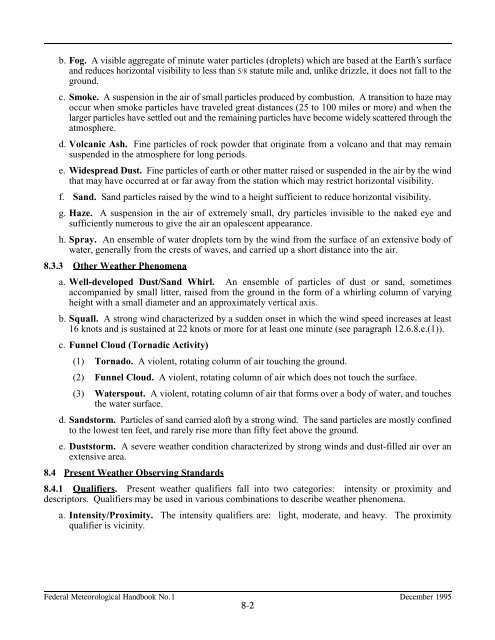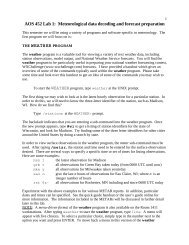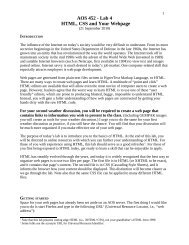Federal Meteorological Handbook No. 1 - Marrella
Federal Meteorological Handbook No. 1 - Marrella
Federal Meteorological Handbook No. 1 - Marrella
You also want an ePaper? Increase the reach of your titles
YUMPU automatically turns print PDFs into web optimized ePapers that Google loves.
. Fog. A visible aggregate of minute water particles (droplets) which are based at the Earth’s surface<br />
and reduces horizontal visibility to less than 5/8 statute mile and, unlike drizzle, it does not fall to the<br />
ground.<br />
c. Smoke. A suspension in the air of small particles produced by combustion. A transition to haze may<br />
occur when smoke particles have traveled great distances (25 to 100 miles or more) and when the<br />
larger particles have settled out and the remaining particles have become widely scattered through the<br />
atmosphere.<br />
d. Volcanic Ash. Fine particles of rock powder that originate from a volcano and that may remain<br />
suspended in the atmosphere for long periods.<br />
e. Widespread Dust. Fine particles of earth or other matter raised or suspended in the air by the wind<br />
that may have occurred at or far away from the station which may restrict horizontal visibility.<br />
f. Sand. Sand particles raised by the wind to a height sufficient to reduce horizontal visibility.<br />
g. Haze. A suspension in the air of extremely small, dry particles invisible to the naked eye and<br />
sufficiently numerous to give the air an opalescent appearance.<br />
h. Spray. An ensemble of water droplets torn by the wind from the surface of an extensive body of<br />
water, generally from the crests of waves, and carried up a short distance into the air.<br />
8.3.3 Other Weather Phenomena<br />
a. Well-developed Dust/Sand Whirl. An ensemble of particles of dust or sand, sometimes<br />
accompanied by small litter, raised from the ground in the form of a whirling column of varying<br />
height with a small diameter and an approximately vertical axis.<br />
b. Squall. A strong wind characterized by a sudden onset in which the wind speed increases at least<br />
16 knots and is sustained at 22 knots or more for at least one minute (see paragraph 12.6.8.e.(1)).<br />
c. Funnel Cloud (Tornadic Activity)<br />
(1) Tornado. A violent, rotating column of air touching the ground.<br />
(2) Funnel Cloud. A violent, rotating column of air which does not touch the surface.<br />
(3) Waterspout. A violent, rotating column of air that forms over a body of water, and touches<br />
the water surface.<br />
d. Sandstorm. Particles of sand carried aloft by a strong wind. The sand particles are mostly confined<br />
to the lowest ten feet, and rarely rise more than fifty feet above the ground.<br />
e. Duststorm. A severe weather condition characterized by strong winds and dust-filled air over an<br />
extensive area.<br />
8.4 Present Weather Observing Standards<br />
8.4.1 Qualifiers. Present weather qualifiers fall into two categories: intensity or proximity and<br />
descriptors. Qualifiers may be used in various combinations to describe weather phenomena.<br />
a. Intensity/Proximity. The intensity qualifiers are: light, moderate, and heavy. The proximity<br />
qualifier is vicinity.<br />
������������������������������������ �������������<br />
���





